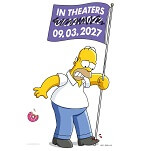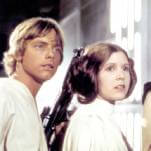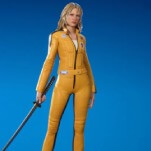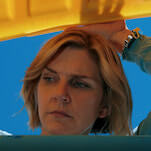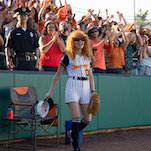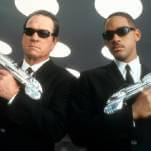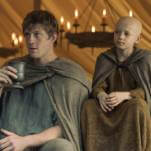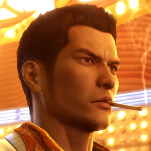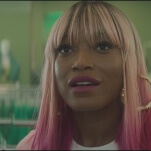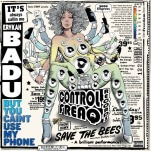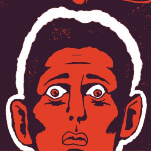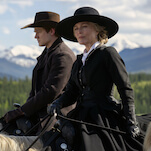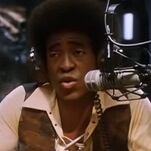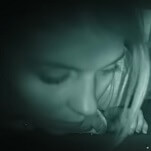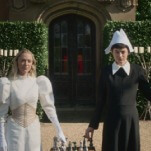Every two weeks, Comics Panel covers recent notable releases along the entire comics spectrum, from superhero/mainstream comics to graphic novels/art comics.
Similar to Super Spy and MIND MGMT, Matt Kindt’s graphic novel Red Handed: The Fine Art Of Strange Crimes (First Second) approaches a pulpy premise from a cockeyed angle, emerging with some surprising, penetrating insights into human behavior and how people relate to their surroundings. Ostensibly a riff on Dick Tracy, Red Handed is about a dedicated, officious cop named “Detective Gould,” whose confidence gets rattled by a series of unusual incidents that defy his conventional understanding of law and order. A spate of chair and sign thefts constitute actual criminal behavior (however odd), but what’s Detective Gould to make of the artist who tricks couples into having arguments and then photographs them? Or the elevator mechanic who surreptitiously takes pictures of women’s legs? Or the art dealer who sells off cut-up pieces of a stolen Picasso?
Red Handed is brilliantly plotted, with each of its initially random pieces coalescing into a clever bit of “everything’s connected” storytelling (similar to movies like P.T. Anderson’s Magnolia, and the books of Paul Auster). More importantly, Kindt uses his fragmented structure to contemplate matters of cause and effect. What series of steps make a crime a crime? Or make art art? Extending that theme, Kindt mixes up his approaches to layout and design, much like Chris Ware and Dan Clowes have done with their more literary comics. Here, Kindt most resembles artist Ben Katchor, both in the scratchy renderings of lumpen figures and the fascination with mysteries that run deeper than who killed whom. Unlike Katchor, though, Kindt is ultimately beholden to the genres in which he dabbles, and as offbeat as Red Handed is, it ultimately works just as well as a satisfying, exciting detective novel.
That’s not to take anything away from Ben Katchor, whose latest collection Hand-Drying In America: And Other Stories (Pantheon) is his best yet, and a prime example of why Katchor’s quizzical, fanciful style has been so influential. Collecting nearly 15 years’ worth of the strips Katchor has drawn for the cutting-edge architecture and design magazine Metropolis, Hand-Drying In America is physically larger than Katchor’s other graphic novels and omnibuses, and though it doesn’t rely on a core character or story-thread, the book does hold mostly to a single theme, dealing with the kinks and quirks of living in a big city. This has been common fare for Katchor, who’s frequently mapped out the collective urban subconscious. With this book, he does more of that, only bigger.
Hand-Drying In America catalogs the guys who empty the crumb-traps of apartment-complex toasters, hails old buildings with vegetable bins built into their kitchen walls, and notes how engineers purposefully include uneven stairs and cracked pavement so that tourists will stumble. Katchor mixes the lightly fantastic with the observational, marveling at strip-mall bingo parlors and hotel room tissue-dispensers, while exaggerating their form and function only slightly. That’s been Katchor’s special genius, to make the phony feel plausible and vice versa, taking advantage of the inherent strangeness of cities to suggest that there are buildings and businesses lurking deep within the great urban sprawl, going largely unrecognized. Katchor’s approach works because it’s rooted in truths about the human nesting instinct, and how people make spaces their own. [NM]
Look into the eyes of the adorable black Labrador puppy staring out from the cover of Gabriel Hardman’s
Kinski #1 (Monkeybrain) and just try not to fall in love. The titular character of Gabriel Hardman’s unconventional crime series is a lost dog that becomes the last hope and salvation of an out-of-towner who becomes obsessed when he finds it in a motel parking lot. After boyish salesman Joe finds the hyperactive puppy, he immediately claims ownership that is quickly snatched from him by Animal Control, and he hatches a plan to get the dog back by any means necessary, even if it means stealing him from the little boy he actually belongs to.
Joe names the dog after a German actor who allegedly sexually abused his daughter for 14 years, an ill omen for the rest of the series, and Hardman excels at building a sense of dread that suggests things are going to go very wrong for Joe as the story continues. The opening pages have a carefree lightness that captures the joy Joe feels when he finds the dog, but once Joe’s coworker asks if he can keep the animal, the tone takes a drastic shift as Joe says, “No. I found him. He’s mine.” Joe has an extremely flawed sense of ownership, and the ways that Hardman explores that through his stark black-and-white artwork is remarkable.
The most haunting moment in Kinski #1 is a silent three-panel sequence showing Joe at a pet store in the mall, buying a pet tag from an automated machine. The first panel is a close-up of Joe sticking a quarter in the machine, emphasizing just little it costs for him to create the tag that makes ownership of the dog legitimate in his mind. The second panel zooms out to fully show both Joe and the machine, which has an image of a small boy and his puppy on the side. It’s not explicitly clear what Joe’s personal situation is, but he’s clearly a lonely, bored person, and the idea of Kinski ties in to that idealized image of a kid having the time of his life with his new puppy.
The third and final panel shows the completed “Kinski” dog tag, a meaningless object that has now been filled with importance by a desperate man. When Joe goes to steal Kinski from his real family, the image he sees in the backyard is a reflection of the picture on the side of the machine; he steals one boy’s reality in order to give himself a fantasy he doesn’t deserve. Hardman is taking a straightforward narrative about a man wanting a dog and transforming it into a layered, suspenseful drama, making Kinski another extraordinary title from Monkeybrain that tells a story you won’t find in any other comic book. It also only costs 99 cents, so there’s no reason not to give this first issue a shot. [OS]
“What would you do if you woke up in a strange room and didn’t know where you were, or what you’d done the night before to get there?” It’s a question asked thrice in the first issue of Jai Nitz and Greg Smallwood’s phenomenal
Dream Thief #1 (Dark Horse), with central character John Lincoln waking up in increasingly dire situations each time. First time: He’s in bed with a woman that isn’t his girlfriend. Second: He’s on the bathroom floor wearing a priceless aboriginal mask, and he’s just killed his girlfriend. Third: He’s in Wilmington, North Carolina, wearing a bloodstained white suit and surrounded by seven murdered gay porn stars. The reader is as in-the-dark about these events as John, although one thing is clear after the first issue of this miniseries: It’s going to be a wild ride finding out what the hell is going on.
Nitz and Smallwood are giving a master class on how to write a first issue with Dream Thief #1, a book that delivers on every level. Nitz has structured a complex narrative with a deluded scumbag at the center, and creating such an unlikeable protagonist makes his misfortune even more effective. John is a man who deserves punishment, but nobody deserves to have his body possessed by dead spirits that use it for their own revenge. Nitz and Smallwood have an incredible partnership, and Smallwood’s visuals are perfectly synchronized to amplify the impact of the script. He sticks to more conventional panel layouts at the start of the issue as Nitz introduces readers to the antihero and his supporting cast, but once John steals the aboriginal mask, the pages become much more experimental.
Smallwood is a relatively new artist who is about to blow up after the impressive skill he shows off in this first issue, which he draws, colors, and inks. The influence of artists like Chris Samnee and Dave Johnson can be found in his page composition, while his coloring evokes the work of Brian Stelfreeze and Nic Klein due to his high-contrast palette. That combination of precise storytelling and visual flair makes this book read like material that is begging for a David Fincher movie adaptation, especially with Nitz’s psychological script. Dark Horse has been on a roll with their recent superhero titles, and the only negative about Dream Thief #1 is that it’s not the beginning of an ongoing series. If this is what Nitz and Smallwood can do with just one issue, imagine how great their partnership could become after working together for years. [OS]
In an effort to boost sales for Kelly Sue DeConnick’s
Captain Marvel and
Avengers Assemble series, Marvel is bringing the titles together for a five-issue crossover launching with
Avengers: The Enemy Within #1 (Marvel). This is really just a continuation of what is happening in the solo series featuring Carol Danvers, focusing on how Captain Marvel deals with a mysterious enemy with the help of Spider-Woman and Thor while suffering from a brain lesion that is keeping her grounded. It sounds heavy, but DeConnick’s titles have stood out for having a light, fun tone without sacrificing dramatic stakes.
Witty dialogue combines with bold superhero action to keep the pace moving at a clip in The Enemy Within, and the writer has done notable work examining the personal motivations for why Carol behaves the way she does. DeConnick hasn’t delved too deeply into Carol’s former alcoholism, instead choosing to look at the heroine’s general addictive tendencies; Captain Marvel doesn’t drink anymore, but she gets her high by putting on the costume and freefalling to Earth from outer space. DeConnick took that away from Carol thanks to the brain lesion, and now she’s dealing with withdrawal, a vicious enemy from her past, and the fact that her lesion might rupture if she keeps trying to be a hero.
Scott Hepburn’s artwork is stylized but more controlled than departing Captain Marvel artist Felipe Andrade, providing visuals that are reminiscent of the expressive, detailed work of Rafael Albuquerque and James Harren. He understands the shifts in DeConnick’s script and transitions seamlessly from comedic talking heads to costumed action, adjusting his layouts accordingly. For dialogue, he uses smaller panels that allow him to incorporate more reaction shots, and then switches to larger widescreen panels once people start hitting each other. This issue may be a new issue of Captain Marvel under a different name, but DeConnick gives new readers all the necessary information they need to jump into one of Marvel’s most delightful titles as it enters its second year. [OS]
Writing for a young-adult audience isn’t easy, requiring the ability to incorporate adult themes into work that can appeal to a wide demographic of readers. Prudence Shen and Faith Erin Hicks’
Nothing Can Possibly Go Wrong (First Second) struggles to balance more mature dramatic material with crowd-pleasing comedy geared toward the high school set. The result is a book that is entertaining but awkwardly paced and not quite as poignant as the script would have readers believe, juggling many storylines and relationships that never get fully developed.
The Hollow Ridge High School robotics team and cheerleading squad are in a war for funds, igniting a political plot to elect their respective candidates as Student Council president. That story takes up most of the first half of the book before being swept away so that the characters can run away from home on Thanksgiving to compete in the Robot Rumble, and in the effort to combine two different narratives, Shen doesn’t have time to check in on the emotional life of her characters. That’s a problem when a major subplot involves protagonist Charlie dealing with his parents’ divorce, which happened five years prior to the events that dominate the earlier part of the story. Charlie starts the book off as spineless, then quickly graduates to petulant as the drama with his parents takes over, and it would have been more effective if Shen chose to focus on the history of that conflict at the start of the book rather than high school pranks.
One thing that is very right with Nothing Can Possibly Go Wrong is Hicks’ artwork, with a style that channels Bryan Lee O’Malley by way of Nickelodeon. Her designs provide immediate insight into the personalities of her characters, contrasting clean-cut jock Charlie with his nerdy, shaggy-haired friend Nate and the wide-eyed pixie Joanna with ambivalent cheerleader Holly, who seems to always be glaring out from behind drooping eyelids. Shen and Hicks have strong creative chemistry, but the book would benefit from a script that is as streamlined and evocative as the artwork. [OS]
And…
Tom De Haven’s 1979 cult novel, Freaks’ Amour, tells the story of two hideous-looking mutants who participate in sex shows to make ends meet in a dystopian future. That basic premise was later copied (most likely unintentionally) by the 1982 X-rated movie classic Café Flesh and Katherine Dunn’s 1989 National Book Award finalist Geek Love; and for years, Swamp Thing artist and Taboo editor Stephen Bissette tried to get a graphic-novel adaptation rolling, with writer Mark Burbey. Instead, Bissette has to settle for penning the introduction to the collected Freaks’ Amour (Dark Horse), which assembles the three-issue comic-book version that Burbey—now known as Dana Marie Andra, following gender-reassignment surgery—wrote with artists Phil Hester and Ande Parks in 1992. Given how powerful De Haven’s story of love among the outcasts is, and how skilled a horror artist Bissette is—not to mention Gary Panter, whose three-page 1980 adaptation is included in this volume—it’s hard not to look on the completed Freaks’ Amour comic and consider what might have been. But Hester and Parks are certainly no slouches, and the version represented here captures not just De Haven’s fevered nightmares, but also the flavor of alternative comics in the early ’90s… [NM]
Speaking of the early ’90s, while Peter Bagge has lately been focusing more on long-form storytelling, he remains one of those première old-school ’80s/’90s alt-cartoonists, who built their careers one corrosively funny one-pager at a time. Peter Bagge’s Other Stuff (Fantagraphics) brings together some stray Bagge comics, a few of which were first released in his original Hate series decades ago. The rarest pieces are collaborations Bagge has done with fellow comics pros like Alan Moore (a grim ’n’ gritty reboot of Kool-Aid Man), Robert Crumb (a riff on deviant sexuality in the comic strip Cathy), Dan Clowes (an exposé of suburban ennui), and Adrian Tomine (a parody of the lives of autobiographical cartoonists). But Other Stuff also brings together strips Bagge has written about rock icons, along with a few cartoon essays, and strips featuring his characters Lovey and The Leeways, who respectively represent hipster adventurism and dogged domesticity. It’s a full picture of who Bagge has been as an artist and humorist over the past 20 years, and as such is as valuable for newcomers as fans… [NM]
May’s other big comic with “dream” in the title is Nathan Edmondson and Konstantin Novosadov’s The Dream Merchant #1 (Image), and it’s a hefty 48-page first issue for the very attractive price of $3.50. Edmondson’s most recent work has primarily been in the action-espionage genre, but he’s moving away from that for this new fantasy-horror hybrid, which follows Winslow, a mental patient in his 20s who can’t differentiate between his dreams and reality. Edmondson’s script is strongest when it focuses on the character relationships, as the more fantastic material doesn’t feel quite as fresh. Familiar faces like the silent villains cloaked in darkness (Dementors, The Nazgûl) and the elderly figure who will guide the hero (Dumbledore, Gandalf) are present, but the connection between Winslow’s mental state and his supernatural abilities adds enough of a twist to elevate the story above mediocrity. The main reason to pick up The Dream Merchant is for 48 pages of stunning Novosadov artwork. Like Greg Smallwood, Novosadov draws, colors, and letters the book, creating a beautifully cinematic look with his widescreen artwork. His panels could be mistaken for screenshots from a high-budget animated film, and his coloring creates an ethereal atmosphere, which contrasts neon-pink dream sequences with the cool blues and drab earth tones of reality. While certain elements of the story may adhere too closely to fantasy conventions, there’s enough character development and visual stimulation in this issue to make for a satisfying read at a great price… [OS]
A clever, poignant twist on the autobio comics format, Jess Fink’s We Can Fix It!: A Time Travel Memoir (Top Shelf) ponders what would happen if the author went back in time to warn her younger selves not to make so many dumb mistakes, whether it be trusting the wrong boy, taking the wrong drug, or acting rudely toward her mother. In keeping with Fink’s interest in erotica—seen recently in her very graphic novel Chester 5000—the time-traveling in We Can Fix It initially devolves into the heroine making out with herself as a teenager. But when she starts trying to dispense advice to the various Lil’ Jesses, she begins to realize that she doesn’t know as much about herself as she thought she did. The result is a book in which Fink treats her own life as a series of loosely connected vignettes, open to different interpretations depending on who she’s become by the time she looks back at them. This isn’t just an effective way to handle autobiography, it’s one with a touching take on the interconnectedness of people’s best and worst moments… [NM]
Though best-known for creating The Smurfs, Belgian cartoonist Pierre Culliford—a.k.a Peyo—had a long career in comics, launching multiple long-running series, both on his own and as the head of his cartooning studio. NBM’s Papercutz line has been reissuing Peyo’s classic Smurf comics as kid-sized graphic albums, and now adds another of Peyo’s best-loved characters: Benoît Brisefer, a super-strong, super-fast little boy whose name roughly translates as “Benny Breakiron” (though in the past, English translations of the Benoît books have called him “Tammy Tuff” and “Steven Strong”). Benny Breakiron: The Red Taxis (NBM/Papercutz) collects the first Benoît story, in which the powerful tyke discovers that a local cab service is a front for the mob, though he has trouble getting any adult to believe him. The Red Taxis establishes many of the motifs of the series, from the trouble the hero has being taken seriously to the way he can be rendered powerless by a common cold. It’s a well-crafted Euro-comic adventure in the Tintin mold, but scaled for a slightly younger audience. [NM]





